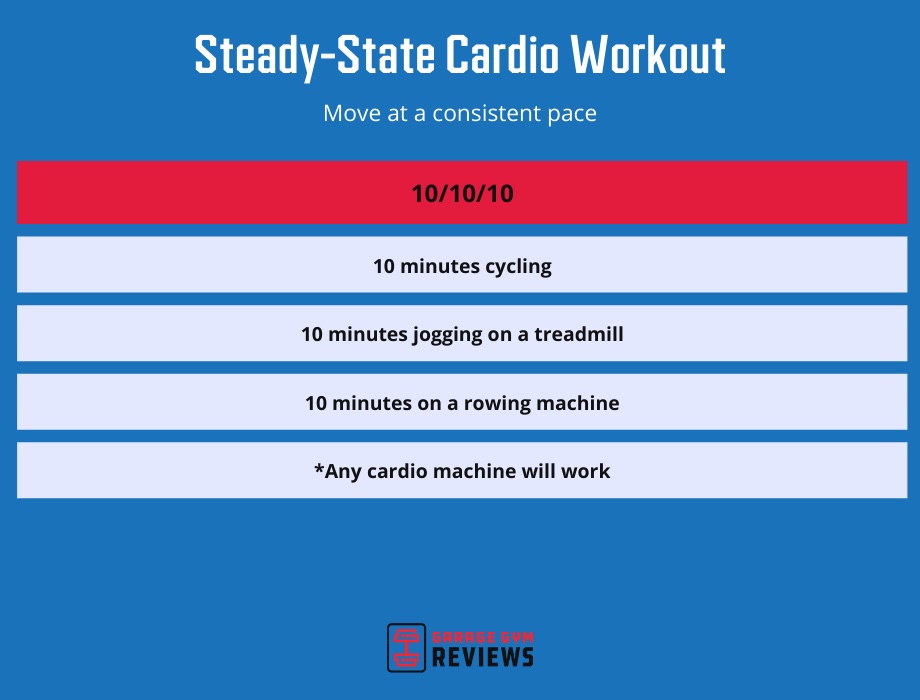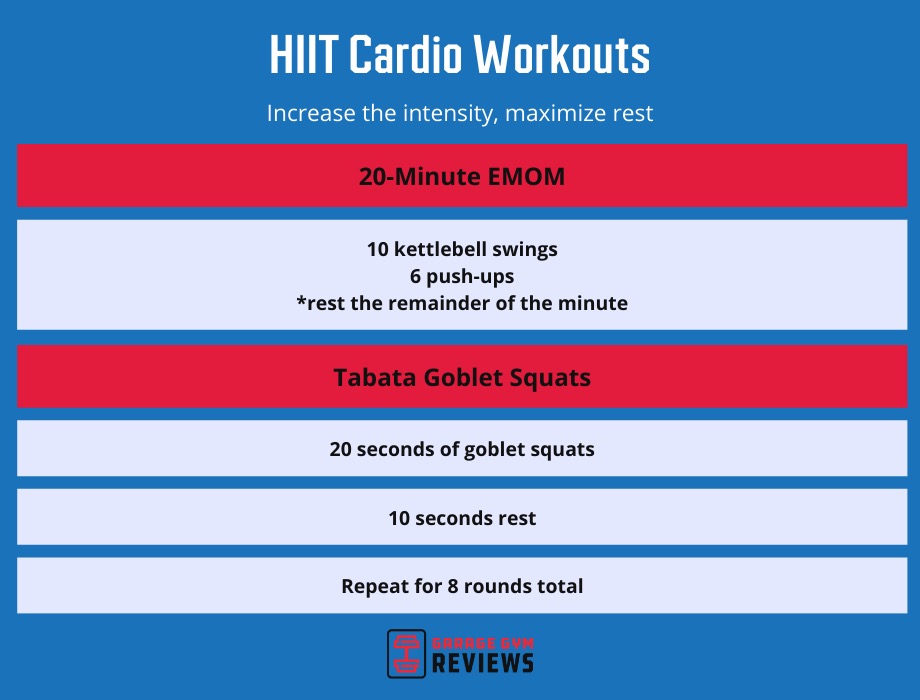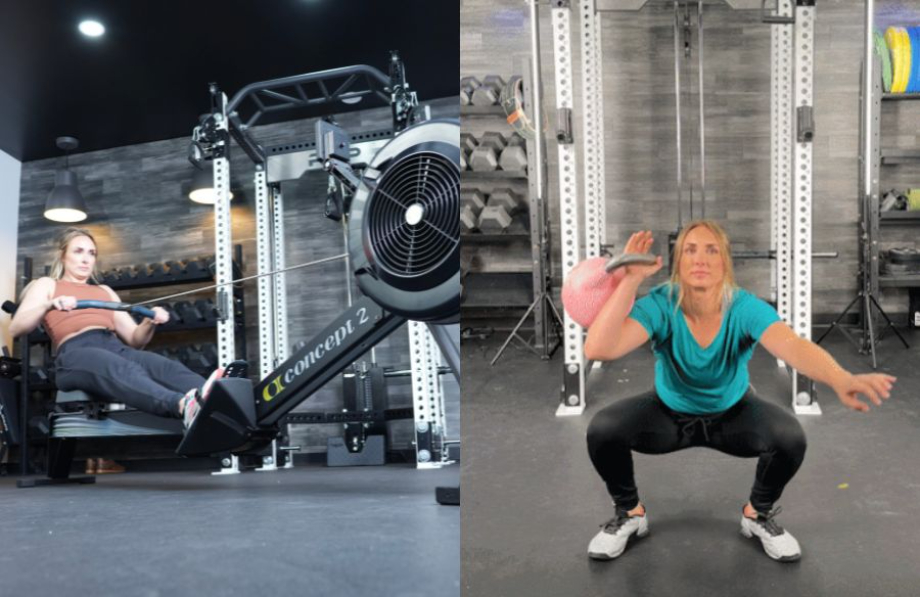We test and review fitness products based on an independent, multi-point methodology. If you use our links to purchase something, we may earn a commission. Read our disclosures.
You’ve decided you need to add some cardio exercise to your routine to burn fat and improve your health, but you’re weighing up the pros and cons of steady-state cardio vs HIIT. Which form of cardio should you choose, and can you do both?
Cardio, no matter the mode, duration, or intensity, has great stress-relieving, calorie-burning benefits as well as the ability to lower blood pressure and reduce the risk of heart disease.
The steady-state cardio vs HIIT camps are firmly entrenched in their views and will always choose one over the other. But you don’t have to be like that, because there is plenty of room in the middle. Here we will explore the pros and cons of both modalities and how to decide which one is for you. As a bonus, we will throw in some workout examples.
Ready to rock and roll? Let’s go.
Medical disclaimer: This article is intended for educational and informational purposes only. It is not a substitute for health or medical advice. For medical advice, contact an appropriate healthcare provider.
What Is Steady-State Cardio?
Steady-state cardio is a form of continuous exercise where you exert yourself at a steady pace for an extended period of time. You perform an exercise at a challenging but manageable pace for 20 to 60 minutes or more at a heart rate between 50 to 70% of your maximum heart rate.
This type of cardio is aerobic because oxygen fuels the exercise. Steady-state cardio training tends to be lower intensity continuous training where you (should) not feel out of breath and gasping for air.
Steady State Cardio
Pros:
- Low-impact exercise
- Stress-reducing
- Improve aerobic endurance
Cons:
- Takes a long time
- Risk of overuse injuries
- Can get dull quickly
Benefits of Steady-State Cardio
Low-Impact: Because of the slower pace, you are not applying as much force to your body. Think of it like going for a jog vs doing sprint intervals. When you jog, you tend to be lighter on your feet than when you’re running fast, and therefore it is a little easier on your joints. This is especially important if you’re suffering from joint pain or injury.
Improved Aerobic Endurance: If you’re training for an endurance event, you’ll be doing a lot of steady-state cardio to grow your ability to cover more distance, like running a marathon. Just like you get stronger by gradually putting more weight on a barbell, you improve your aerobic capacity by gradually making steady-state workouts longer.
However, studies show that longer and slower cardio helps you increase the size of your heart’s left ventricle, allowing you to pump more blood per heartbeat. This, in turn, helps you improve your aerobic endurance.
Stress-Reducing: Aerobic exercise helps increase blood flow to your brain, which is great for clearing stress and reducing anxiety, depression, and negative moods, and improving self-esteem.
Downsides of Steady-State Cardio
Takes a Long Time: Going for a long bike ride simply takes a long time. If you have a busy schedule, steady-state cardio may not always be an option.
Risk Of Overuse Injuries: Performing the same repetitive motions from the same cardio activities may cause overuse injuries. For example, many runners suffer from injuries like shin splints for plantar fasciitis, both of which can stem from logging lots of miles on your feet.
Can Get Dull Fast: If you’re the type of person who is easily bored, then steady-state cardio isn’t for you.
What Is HIIT?
HIIT is short for high-intensity interval training. This type of workout involves short, intense cardiovascular intervals that are followed by a lesser intense recovery interval and repeated for sets. HIIT intervals usually last between 20 seconds to 3 minutes with the same amount of recovery or more before doing it again.
This is an anaerobic, high-intensity exercise protocol. As opposed to oxygen fueling the exercise, HIIT is fueled by the energy stored in the muscles called glycogen (stored glucose). During HIIT, you operate at high heart rate levels and around 90% of your VO2 max.
HIIT
Pros:
- Shorter workouts that take less time
- Better caloric afterburn
- Improve performance
Cons:
- Risk of injury
- Risk of overtraining
- Can be uncomfortable
Time-Efficient Workouts: It takes less amount of time to get the same or improved training adaptations from HITT sessions than it does from steady-state cardio. If you’re a person who is short on time, this is more for you.
Benefits of HIIT
Better Caloric Afterburn: It’s widely held that for every liter of oxygen you breathe, you burn 5 calories. Because your body is playing catch up after HIIT, you require more oxygen to recover from your HIIT workouts. Therefore, you burn more calories after your training. This is known as EPOC or excess post-exercise oxygen consumption. (Bonus: This can help reduce your body fat, too.)
Improved Performance: HIIT training can improve your aerobic and anaerobic exercise because your aerobic system is working overtime to get oxygen to your muscles after finishing your HIIT training. And this will improve your fat-burning capabilities too. Plus, by performing HIIT with weights, you have the potential to build muscle.
Downsides of HIIT
Higher Risk Of Injury: HIIT training usually involves higher impact, higher intensity activities that may wear on the joints and carry a bigger risk of muscle strains and joint sprains than steady-state.
Overtraining Risk: Due to the higher intensity nature of HIIT and its great benefits, there is a temptation to do it all the time. But when it’s not performed with adequate recovery between sessions, studies suggest there will be a decrease in performance and an increased risk of burnout.
Can Be Extremely Uncomfortable: Due to the anaerobic nature of HIIT, your lungs will be burning, and the same for your muscles due to the rise in lactic acid. Yes, the burning will hurt, but it will increase your mental toughness, too. It matters here whether you can stand the heat in the kitchen.
Should You Do Steady-State Cardio or HIIT?
First things first: According to this study, you will get the same health and performance benefits from HIIT and moderate intensity steady-state cardio sessions. So, if you hear people saying HIIT is better for burning fat and weight loss and you should only do HIIT, it’s bogus.
I like to recommend that people incorporate both modalities into their fitness routines if your lifestyle allows for it.
Choosing Steady-State
HIIT may not be the best option for you if you already have a lot of stress in your life. The high intensity adds stress—even good stress—to your body, which will affect your ability to recover from your HIIT workouts. In this case, it may be better to stick with the stress-reducing benefits of steady-state cardio.
Also, if you’re a beginner and have yet to build up an aerobic base, then sticking with steady-state cardio for a couple of months will benefit you. Yes, you can try HIIT, but your performance could suffer because your recovery between intervals will not be enough to be able to get the most out of the workout.
Also, building an aerobic base through steady-state cardio may boost your confidence to give HIIT a try down the line. Also, people with joint issues or low back pain may want to avoid fast-paced, high-impact, high-intensity activities. Choosing high-intensity, low-impact workouts is your best bet, like bike workouts or kettlebell intervals.
Choosing HIIT
Now, if you have a good aerobic base and engage in resistance training a couple of times a week (or one or the other), then HIIT could be a great way to boost your performance and increase your overall fitness.
Also, if you are short on time and want to blend strength training with cardio activities, then HIIT sessions could be the solution. Generally, you can get a great HIIT workout in less than 30 minutes, from warmup to cool-down.
At the end of the day, doing both types of cardio would be preferable. But doing one type of cardio over another is a matter of time, preference, and your personal fitness goals.
RELATED: Cardio vs. Strength Training
Is HIIT or Steady-State Better for Fat Loss
The big money question remains: Which cardiovascular protocol is better for fat loss: HIIT, or steady-state cardio?
With steady-state, you are burning more fat during your training, because your body tends to pull from fat storages for fuel as opposed to carbs. However, after a steady-state workout, you may not burn as many calories compared to post-HIIT periods, because EPOC will be less of a factor.
In HIIT training, which is anaerobic, your body uses glycogen for fuel, not fat. But afterward, your body will be playing oxygen catch-up (EPOC), and you’ll be burning more calories after your workout when compared to steady-state.
Researchers set out to find the answer to this question, and the answer is: They both get results, and the results aren’t statistically significant to declare one better than the other. After reviewing 56 studies on HIIT vs steady-state cardio, these researchers also noted that even the EPOC afterburn difference was “modest.”
So, again, the better exercise for weight loss or fat loss is going to be the exercise that you’re most likely to do and continue doing based on your lifestyle and fitness goals.
Steady-State Training Workouts
The first and simplest aerobic exercise you could do is to do 30 minutes of a single form of cardio exercise: go for a brisk walk, use a rowing machine, and head out for a jog.
However, if that doesn’t strike your fancy, know that steady-state training doesn’t have to feel boring.
Who says you have to do the same activity for the entire duration of your workout? With the 10/10/10 training, you can choose three cardio workout modes to decrease boredom and increase enjoyment. Here is a steady-state training you can try depending on your accessibility to cardio equipment.

10/10/10 Training
- 10-minute bike
- 10-minute run (on the treadmill or outside)
- 10-minute row
How To Do It:
Place the treadmill on an incline and set the speed to a brisk walking pace around 3 to 3.5 MPH. Your goal is to find a pace on all machines in which your heart rate is elevated, but you are still able to breathe easily.
If you don’t have access to all of these, any cardio machine or activity will do: jumping jacks, jump rope, SkiErg, elliptical, or stair climber. Just choose three different modes and work at a pace that is continuous.
RELATED: Jumping Rope Vs Running
HIIT Workout to Try
HITT training usually involves high-intensity, high-impact exercise. But when performing kettlebell swings, you get the intensity without the impact. And here are a few high-intensity workouts you can try to spice things up. (Also, you’ll definitely experience the EPOC afterburn effect after these workouts).

EMOM Swings/Push-ups
Every minute on the minute for 10 to 20 minutes:
- 10 kettlebell swings
- 6 push-ups
How to Do It:
Start a clock. Perform 10 swings and six push-ups and rest the remainder of the minute. Then repeat this superset every minute on the minute for 10 to 20 minutes. To increase the intensity, increase the number of push-ups but not swings.
Goblet Squat Tabata Timed Sets
8 Rounds:
- 20 seconds of goblet squats
- 10 seconds of rest
Sample Week of Doing Steady-State Cardio And HIIT
When performing both in the same week, it’s important to space your HIIT workouts to improve your recovery and avoid overtraining. Performing steady-state cardio between HIIT workouts works well.
Here is an example.
Monday: HIIT training doing 30 seconds of work and a minute of rest on any cardio machine. Warm-up and cool down 3 to 5 minutes before and afterward.
Tuesday: Steady-state cardio 20-30 minutes of any lower intensity activity, like walking or biking.
Wednesday: Rest or a long-distance walk.
Thursday: Kettlebell HIIT training workout above or a 15/45-second interval on any cardio machine (work intensely for 15 seconds, rest for 45 seconds).
Friday: 20-30 minutes of any low-intensity cardio activity.
Saturday: HIIT training or any low-intensity cardio activity. Your choice. Sunday: Rest.
FAQs About Steady-State Cardio vs HIIT
Is steady-state cardio better than HIIT?
Let’s be careful here. One is not better than the other, but they are both different. Studies show that they both have similar health benefits, so it is a matter of joint health, time, and preference.
Which burns more fat: steady-state cardio, or HIIT?
Given the same time on both activities, HIIT may burn slightly more fat because of the calories burned after you have finished due to EPOC (excess post-exercise oxygen consumption).
Should I do HIIT and steady-state together?
Yes, because they’ll both benefit you. HIIT will improve your aerobic system for steady-state, and improving your aerobic cardiovascular system through steady-state will improve your HIIT.
VO2 Max Calculator
We created our own VO2 max calculator so you can estimate your cardiovascular fitness level.
Further reading

Get the heart-healthy benefits of a cardio machine without spending a ton of money. Check out our list of the best treadmills under $600. Read more

Wondering how to get sweat smell out of clothes after you exercise? Here’s how to do it. Read more

Is protein powder bad for your kidneys? A registered dietitian explains how to support your kidneys without sabotaging your gains! Read more

Looking for a no-equipment workout? Try these 10 best bodyweight exercises for building muscle and strength, straight from a certified personal trainer. Read more

